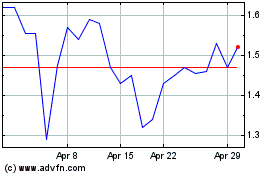By Julia-Ambra Verlaine
No one said replacing the London interbank offered rate would be
easy, but many regulators and investors contend the cumbersome
process remains on track despite setbacks including the global
coronavirus pandemic.
Deeply rooted in markets after decades and linked to trillions
of dollars of financial products, Libor is slated for replacement
by the end of 2021. Policy makers and regulators moved to scrap the
benchmark after concluding it was balky and prone to manipulation,
as exposed by a 2012 scandal that led to convictions for some
traders and penalties for numerous banks.
If the transition doesn't go as planned, it could leave everyone
worse off. Consumers could end up on the hook for increased
payments on credit-card loans and other borrowings, while small
businesses could face higher fixed rates for loans. About $190
trillion of interest-rate derivatives and $3.4 trillion of business
loans are tied to the rate.
Bankers and others in the market for short-term lending say a
number of developments this year give them confidence that they can
manage Libor's demise and the transition to alternative lending
benchmarks.
A Federal Reserve committee of regulators, banks and asset
managers chose the Secured Overnight Financing Rate, or SOFR, as
the official replacement.
The Alternative Reference Rates Committee, consisting of major
banks, insurers and asset managers alongside the New York Fed, have
been rallying derivatives investors and users of Libor to be ready
for the end. Fannie Mae and Freddie Mac have said they would stop
accepting adjustable-rate mortgages tied to Libor by the end of
2020. Banks are spending millions of dollars and mobilizing
everyone from lawyers to trading-floor staff.
But efforts were put on ice for more than a month as financial
institutions grappled with tumbling stocks, margin calls and
clients racing for cash as the coronavirus sent markets into a
tailspin prompting unprecedented action by the Fed.
The temporary breakdown of U.S. Treasury markets in March led
some to question the stability of SOFR, which is based on the cost
of transactions in the market for overnight repurchase agreements,
or repos. That is where financial companies borrow cash overnight
using U.S. government debt as collateral.
SOFR dropped to 0.26% on March 16 before doubling the next day,
only to fall again. Moves that week reminded investors of
volatility last September, when SOFR surged above 5% because of
idiosyncratic strains in the repo market.
"There is a growing consensus that SOFR as a replacement for
Libor doesn't really work," said Scott Shay, co-founder of New
York-based Signature Bank.
Smaller and midsize banks are favoring another benchmark:
Ameribor. Established by Richard Sandor, a key player in the
creation of futures markets in the 1970s, Ameribor is based on
rates set on the American Financial Exchange, which he founded.
Smaller banks say Ameribor reflects the cost of funds in trading
in financial markets for banks that aren't among the Fed's
exclusive counterparties -- also known as primary dealers.
Some wonder whether the deadline for the transition away from
Libor will be pushed back. Investment-bank analysts and salespeople
estimate that only a quarter of clients are ready for the benchmark
to disappear.
"I think Libor will go away, but will everybody be ready for it
in 18 months?" said Paul Noring, managing director at BRG, a
consulting firm in Washington, D.C.
Tom Wipf, a vice chairman at Morgan Stanley who is chairman of
the Alternative Reference Rates Committee, said that the move to
SOFR was on track and that the committee was able to double the
number of virtual meetings -- with travel schedules restrained by
lockdowns related to the pandemic -- to get the job done.
He said policy makers weren't pleased with Libor's volatility
during the March stress period, underscoring the need to make the
transition in a timely manner.
"All the concerns that got us here in the first place were
revealed again during that period of market stress," said Mr.
Wipf.
The U.K. regulator in charge of overseeing Libor made it clear a
deadline extension was out of the question. Edwin Schooling Latter,
a senior regulator at the Financial Conduct Authority, said in July
that Libor's death notice wouldn't be pushed back by the impact of
the coronavirus.
"The four to six months ahead of us are arguably the most
critical period in the transition away from Libor," Mr. Latter said
in a speech.
Josh Younger, head of interest-rate derivative research at
JPMorgan Chase & Co., said investors and asset managers saw
significant risks of a delay until U.K. officials came up with a
solution in June to overcome one of the biggest hurdles blocking a
smooth transition away from Libor: so-called tough legacy
contracts.
These include floating-rate notes that require bondholders to
agree on a new reference rate, which is a nearly impossible task,
according to lawyers at companies advising banks and clients.
To avoid litigation, the U.K. government said in June it would
amend the rulebook, handing the FCA, the benchmark's overseer, the
power to craft what some call a "zombie-type" Libor that could
exist for certain legacy contracts.
"Dealing with tough legacy contracts potentially accelerates the
time frame over which this transition can happen," Mr. Younger
said.
Write to Julia-Ambra Verlaine at Julia.Verlaine@wsj.com
(END) Dow Jones Newswires
August 14, 2020 08:03 ET (12:03 GMT)
Copyright (c) 2020 Dow Jones & Company, Inc.
Fannie Mae (QB) (USOTC:FNMA)
Historical Stock Chart
From Dec 2024 to Jan 2025

Fannie Mae (QB) (USOTC:FNMA)
Historical Stock Chart
From Jan 2024 to Jan 2025
